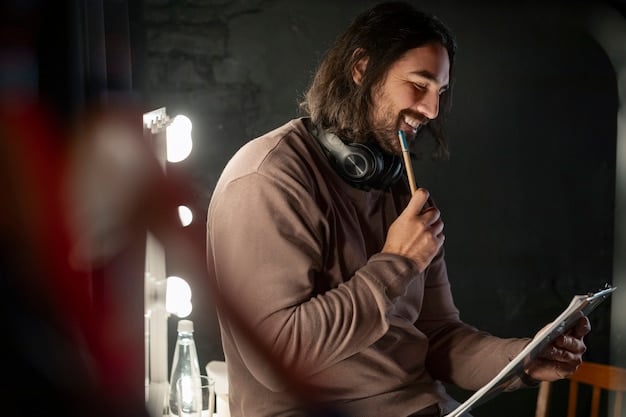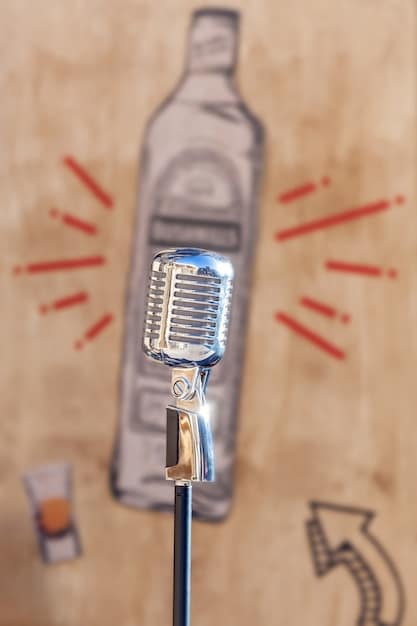Rock Interview Mastery: Asking the Right Questions for Honest Answers

The Art of the Rock Interview involves skillful questioning and a genuine connection, enabling interviewers to elicit candid and compelling responses from musicians, offering readers profound insights into their creative processes and personal stories.
Unlocking the true stories behind rock legends requires more than just a microphone; it demands the artistry of asking the right questions. The Art of the Rock Interview: How to Ask the Right Questions and Get Honest Answers is a skill honed by understanding the nuances of human connection and musical passion.
Understanding the Rock Star Mindset
To conduct a truly compelling rock interview, it’s essential to step into the world of the artist. This involves understanding their creative process, their influences, and the pressures they face. Recognizing the unique mindset of rock stars sets the stage for more meaningful and authentic interactions.
Every rock star has a story that goes beyond the stage persona. By understanding their background, their struggles, and their inspirations, you can craft questions that resonate deeply and elicit more profound responses. This empathetic approach is crucial for establishing trust and rapport.
Research is Key
Before you even think about asking a question, dive deep into the artist’s history. Read their biographies, listen to their albums countless times, and watch any interviews they’ve given. This thorough preparation demonstrates your respect for their work and ensures that your questions are informed and insightful.
Recognizing Creative Influences
Understanding the artists who inspired the rock star can unlock new avenues of conversation. Ask about their musical heroes, their favorite albums, and how these influences shaped their own sound. This line of questioning can reveal unexpected facets of their artistic identity.
- Knowing their discography inside and out.
- Understanding their personal history and influences.
- Being aware of their current projects and future plans.
- Respecting their privacy and avoiding overly personal questions early on.
Understanding the rock star mindset goes beyond superficial knowledge. It’s about genuinely connecting with their passion, their struggles, and their creative spirit. This preparation will allow you to ask questions that are not only informed but also deeply engaging, leading to memorable and revealing interviews.

Crafting the Perfect Question
The art of the rock interview lies in asking the right questions, and creating the perfect question is a delicate balance of precision and open-endedness. A well-crafted question should invite more than just a yes or no answer; it should stimulate thought, reflection, and storytelling. Learning to master this craft is crucial for any aspiring interviewer.
Open-ended questions encourage the artist to elaborate, share anecdotes, and express their feelings. These types of questions allow for unexpected revelations and deeper insights into their experiences. Closed-ended questions, on the other hand, can limit the conversation and stifle creativity.
Open-Ended vs. Closed-Ended Questions
The key difference between these two types of questions is the level of detail they elicit. Open-ended questions begin with phrases like “Tell me about…” or “How did you feel when…?”, while closed-ended questions often start with “Did you…?” or “Have you…?”. Strategic use of open-ended questions can lead to richer and more engaging responses.
The Power of “Why?”
Asking “Why?” can be incredibly powerful, but it should be used with caution. When used correctly, it can prompt the artist to delve into the motivations and reasoning behind their actions or beliefs. However, overuse can feel accusatory or invasive, so it’s important to use this question judiciously.
- Start with broad, general questions to ease the artist into the conversation.
- Gradually narrow down the focus to more specific and personal topics.
- Be prepared to deviate from your prepared questions if the conversation takes an interesting turn.
Crafting the perfect question involves understanding the nuances of language and psychology. By asking open-ended questions, probing for deeper meanings, and being mindful of your tone, you can create an environment where the artist feels comfortable sharing their authentic self.
Building Rapport and Trust
The foundation of any successful rock interview is built on rapport and trust. Without these elements, the artist is unlikely to open up and share their true thoughts and feelings. Building a genuine connection takes time, patience, and a willingness to listen more than you speak.
Establishing trust involves demonstrating respect for the artist’s work, acknowledging their accomplishments, and showing genuine interest in their perspective. When an artist feels valued and understood, they are more likely to let their guard down and engage in a meaningful conversation.
Active Listening Techniques
Active listening is a critical skill for building rapport. This involves paying close attention to what the artist is saying, both verbally and nonverbally, and responding in a way that shows you understand and appreciate their point of view. Nodding, making eye contact, and summarizing their points are all effective active listening techniques.
Finding Common Ground
Identifying shared interests or experiences can help to create a sense of connection and understanding. Perhaps you both grew up in the same town, share a love for a particular genre of music, or have faced similar challenges in your careers. Finding these commonalities can help to bridge the gap and establish a deeper level of rapport.
- Be authentic and genuine in your interactions.
- Show empathy and understanding for their experiences.
- Avoid interrupting or dominating the conversation.
Building rapport and trust is an ongoing process that requires sensitivity, patience, and genuine interest. By prioritizing these elements, you can create an environment where the artist feels safe, respected, and willing to share their most authentic self, leading to an interview that is both insightful and memorable.
Navigating Sensitive Topics
Every rock star has personal stories that they may consider off-limits. Knowing how to approach sensitive subjects with tact and respect is an essential skill for any interviewer. It’s a dance between curiosity and caution, ensuring that you gather valuable insights without overstepping boundaries.
Knowing how to deal with sensitive topics becomes essential in earning the artist’s trust and preventing an unintentional offense. If handled poorly, these issues might damage the interview and jeopardize your reputation as a journalist.
Reading Body Language
Paying attention to the artist’s nonverbal cues can provide valuable insight into their comfort level. If they become fidgety, avoid eye contact, or give short, clipped answers, it may be a sign that you’ve touched on a sensitive topic. Recognizing these cues allows you to adjust your approach and avoid causing unnecessary discomfort.
Offering an “Out”
If you accidentally stumble upon a sensitive topic, it’s important to give the artist an “out.” This could involve saying something like, “If you’d rather not discuss this, I completely understand.” Providing this option shows respect for their boundaries and allows them to gracefully steer the conversation in a different direction.
- Ask permission before delving into personal or controversial topics.
- Be prepared to change the subject if the artist becomes uncomfortable.
- Respect their right to privacy and avoid pushing them to reveal more than they’re willing to share.
Navigating sensitive topics is a skill that requires empathy, awareness, and a deep respect for the artist’s boundaries. By honing these qualities, you can conduct interviews that are both revealing and respectful, preserving the dignity of the artist while still delivering compelling content.
The Importance of Authenticity
In an era saturated with curated personas and manufactured narratives, authenticity is more valuable than ever. Striving for authenticity in your interviews becomes paramount to delivering genuine and impactful stories. Authenticity is the key that unlocks the true essence of the artist and captivates your audience.
Authenticity means being yourself, asking genuine questions, and listening with an open heart. It’s about creating a space where the artist feels safe to be themselves, without fear of judgment or manipulation. This genuine connection enables you to gather the most accurate stories and meaningful insights.
Showing Your True Self
Letting your personality shine through can help the artist feel more comfortable and connected. This doesn’t mean dominating the conversation or making it about yourself; rather, it means being genuine, approachable, and relatable. When the artist senses your sincerity, they are more likely to open up and share their own authentic self.
Avoiding Canned Questions
Steer clear of generic, formulaic questions that have been asked a million times before. Instead, focus on crafting unique, thoughtful questions that demonstrate your understanding of the artist’s work and perspective. This personalized approach shows that you’re genuinely interested in hearing their story, not just checking off a list of questions.

- Be true to yourself and let your personality shine through.
- Avoid asking questions that you think the artist wants to hear.
- Focus on creating a genuine connection and fostering a sense of trust.
Embracing authenticity in your rock interviews allows you to transcend the superficial and tap into the deeper, more meaningful aspects of the artist’s story. This authenticity not only enhances the quality of your interviews but also strengthens your credibility as a journalist, establishing you as a trusted voice in the industry.
Post-Interview Reflection and Analysis
After the interview is concluded, the process of reflection and analysis begins, as it offers an opportunity to distill the essence of the conversation, unearth hidden insights, and refine your approach for future interviews. Thorough reflection is an indispensable step in turning a good interview into a great piece of journalism.
Taking the time to review your notes, listen to the recording, and reflect on the artist’s responses can reveal nuances and patterns that you may have missed in the moment. This thorough analysis allows you to craft a more compelling and insightful narrative.
Identifying Key Themes and Insights
As you review the interview, look for recurring themes or patterns in the artist’s responses. What are the key messages they were trying to convey? What insights did they offer about their creative process, their personal life, or the music industry? Identifying these themes will help you to structure your article and highlight the most important takeaways.
Assessing Your Performance
Be honest and critical in evaluating your own performance as an interviewer. What questions worked well? Which ones fell flat? Were you able to build a strong rapport with the artist? What could you have done differently? This self-assessment will help you to identify areas for improvement and refine your interviewing techniques.
- Transcribe the interview to facilitate detailed analysis.
- Organize your notes and identify key quotes and anecdotes.
- Draft an outline for your article, focusing on the most compelling themes and insights.
Post-interview reflection and analysis transforms a raw conversation into a polished, insightful piece of journalism. This thoughtful approach not only enriches your storytelling but also enhances your skills as an interviewer, setting the stage for even more impactful conversations in the future.
| Key Point | Brief Description |
|---|---|
| 🎤 Understanding the Artist | Research their background and influences to connect better. |
| ❓ Crafting Perfect Questions | Use open-ended questions to encourage detailed answers. |
| 🤝 Building Rapport | Establish trust through active listening and empathy. |
| 🚫 Navigating Sensitivity | Handle personal topics with respect and caution. |
Frequently Asked Questions
▼
Building a genuine connection with the artist is crucial. Authenticity and empathy create a space where they feel comfortable sharing honestly and openly, leading to more insightful responses.
▼
Thorough research is key. Dive deep into the artist’s history, listen to their music extensively, and be aware of their current projects. Understanding their background helps craft informed questions.
▼
Avoid generic, canned questions that have been asked repeatedly. Steer clear of overly personal or intrusive questions, especially early in the interview, to respect the artist’s boundaries.
▼
Approach sensitive topics with tact and respect. Pay attention to the artist’s body language and offer an “out” if they appear uncomfortable. Always prioritize their comfort and privacy.
▼
Authenticity builds trust. Letting your personality shine through and asking genuine questions help the artist relax and share their true selves, resulting in richer, more meaningful insights.
Conclusion
Mastering the art of the rock interview involves a blend of preparation, empathy, and authenticity. The goal is to create an environment where artists feel comfortable sharing their stories, providing audiences with unique perspectives and a deeper understanding of the creative process.





